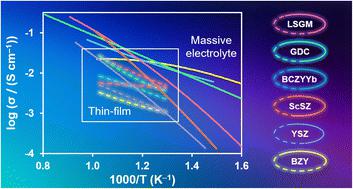当前位置:
X-MOL 学术
›
J. Mater. Chem. A
›
论文详情
Our official English website, www.x-mol.net, welcomes your feedback! (Note: you will need to create a separate account there.)
Revisiting the ionic conductivity of solid oxide electrolytes: a technical review
Journal of Materials Chemistry A ( IF 10.7 ) Pub Date : 2024-09-02 , DOI: 10.1039/d4ta03852e Danil E. Matkin , Inna A Starostina , Muhammad Bilal Hanif , Dmitry Medvedev
Journal of Materials Chemistry A ( IF 10.7 ) Pub Date : 2024-09-02 , DOI: 10.1039/d4ta03852e Danil E. Matkin , Inna A Starostina , Muhammad Bilal Hanif , Dmitry Medvedev

|
Oxygen-ionic and proton-conducting oxides are an important class of functional materials for their applications as electrolytes in various high-temperature electrochemical cells, including solid oxide fuel cells (SOFCs), solid oxide electrolysis cells (SOECs), proton ceramic fuel cells (PCFCs), and proton ceramic electrolysis cells (PCECs). The electrolyte, as a heart of these cells, must meet a number of stringent requirements, among which its ionic conductivity is one of the most important parameters determining the possible applications in electrochemical devices and operating temperatures. In the present work, we provide a comparative analysis of the ionic conductivity for several classical electrolyte classes, such as stabilized/doped ZrO2, CeO2, LaGaO3, BaCeO3, BaZrO3, and Ba(Ce,Zr)O3. This analysis provides possible windows of conductivity variation and potential (common and specific) factors responsible for conductivity differences for the same materials and measurement conditions. In addition, the ionic conductivity is discussed not only for massive ceramic electrolytes, but also for their thin-film form in SOFCs/PCFCs or SOECs/PCECs. As a result, the transport properties of the state-of-the-art electrolytes have been revised and compared to show which system prevails over the other under different experimental conditions. Therefore, this technical review can be used as a reference source to provide useful information on oxygen-ionic and protonic conductivity for the most popular solid oxide electrolytes.
中文翻译:

重新审视固体氧化物电解质的离子电导率:技术回顾
氧离子和质子传导氧化物是一类重要的功能材料,可用作各种高温电化学电池中的电解质,包括固体氧化物燃料电池(SOFC)、固体氧化物电解电池(SOEC)、质子陶瓷燃料电池( PCFC)和质子陶瓷电解池(PCEC)。电解质作为这些电池的心脏,必须满足许多严格的要求,其中其离子电导率是决定电化学装置中可能的应用和工作温度的最重要参数之一。在目前的工作中,我们对几种经典电解质类别的离子电导率进行了比较分析,例如稳定/掺杂的 ZrO 2 、CeO 2 、LaGaO 3 、BaCeO 3 、BaZrO 3和 Ba(Ce,Zr)O 3 。该分析提供了电导率变化的可能窗口以及导致相同材料和测量条件下电导率差异的潜在(常见和特定)因素。此外,不仅讨论了块状陶瓷电解质的离子电导率,还讨论了 SOFC/PCFC 或 SOEC/PCEC 中薄膜形式的离子电导率。因此,对最先进电解质的传输特性进行了修改和比较,以显示在不同的实验条件下哪种系统优于另一种系统。因此,本技术综述可作为参考来源,为最流行的固体氧化物电解质提供有关氧离子和质子电导率的有用信息。
更新日期:2024-09-06
中文翻译:

重新审视固体氧化物电解质的离子电导率:技术回顾
氧离子和质子传导氧化物是一类重要的功能材料,可用作各种高温电化学电池中的电解质,包括固体氧化物燃料电池(SOFC)、固体氧化物电解电池(SOEC)、质子陶瓷燃料电池( PCFC)和质子陶瓷电解池(PCEC)。电解质作为这些电池的心脏,必须满足许多严格的要求,其中其离子电导率是决定电化学装置中可能的应用和工作温度的最重要参数之一。在目前的工作中,我们对几种经典电解质类别的离子电导率进行了比较分析,例如稳定/掺杂的 ZrO 2 、CeO 2 、LaGaO 3 、BaCeO 3 、BaZrO 3和 Ba(Ce,Zr)O 3 。该分析提供了电导率变化的可能窗口以及导致相同材料和测量条件下电导率差异的潜在(常见和特定)因素。此外,不仅讨论了块状陶瓷电解质的离子电导率,还讨论了 SOFC/PCFC 或 SOEC/PCEC 中薄膜形式的离子电导率。因此,对最先进电解质的传输特性进行了修改和比较,以显示在不同的实验条件下哪种系统优于另一种系统。因此,本技术综述可作为参考来源,为最流行的固体氧化物电解质提供有关氧离子和质子电导率的有用信息。





































 京公网安备 11010802027423号
京公网安备 11010802027423号